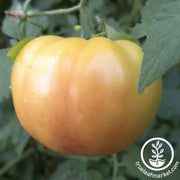Out Of Stock!
We will notify you when this product becomes available.
Tomato Seeds - Slicing - Hillbilly
85-94 Days to maturity (from transplant). Solanum lycopersicum. Hillbilly Tomato Seeds. Non-GMO, warm season annual, open-pollinated, heirloom, indeterminate, slicing tomato. Suitable for growing in garden plots, raised beds, and greenhouses. Originating in West Virginia, our beefsteak 1-2 lb Hillbilly tomatoes are insanely delicious. ~ 6,800 seeds/ounce.




Download Free Vegetable Growing Guide PDF
Growing Hillbilly Tomatoes in the Vegetable Garden
To plant Organic Hillbilly Tomatoes, start indoors 7-9 weeks before the last spring frost date in your region. Sow the seeds at a depth of 0.25 inches in well-draining, loose, slightly acidic soil with a pH range of 6.2 to 6.8. Given their indeterminate growth habit, provide support such as a cage or trellis to accommodate their sprawling vines. These tomatoes exhibit a vibrant yellow and orange color, coupled with a sweet, juicy, low acid flavor and a hint of apricot. Transplant the seedlings outdoors after the danger of frost has passed, spacing them 24-36 inches apart, with rows spaced 36 inches apart. The tomatoes will mature in 85-94 days from transplant, making them late-season producers. While challenging to yield by the 4th of July, they offer a rewarding late-summer to early-fall harvest for most USDA zones. Emphasize well-drained, sandy loam soil, maintain a warmer temperature range of 70-85°F, and expose them to full sun.
Optimal maintenance practices are essential for cultivating healthy and productive Organic Hillbilly Tomatoes. Given their indeterminate growth habit, provide sturdy support with cages or trellises to manage their sprawling vines. Regular pruning, particularly of lower leaves, encourages air circulation, reduces disease risk, and directs energy toward fruit production. Mulching around the base of the plants helps retain moisture and suppress weeds. Companion planting with basil can deter common pests while enhancing the tomatoes' flavor. Consistent watering is crucial, avoiding both drought stress and waterlogged soil. Fertilize sparingly, prioritizing phosphorus and potassium to encourage fruiting. Check for pests like tomato hornworms and diseases such as late blight regularly, using organic neem-based products for prevention and treatment. Rotate crops annually to minimize soil-borne diseases.
Harvesting Hillbilly Tomatoes
Harvesting Organic Hillbilly Tomatoes is a delightful process marked by their vibrant colors and unique flavor profile. As an indeterminate variety, these tomatoes continue to produce fruit throughout the growing season, offering a staggered harvest window. The 85-94 days from transplant maturity period provides a general guideline, but optimal ripeness is best determined by the tomatoes' vivid yellow and orange color, coupled with their sweet, juicy, and subtly apricot-flavored taste. Individual tomatoes are typically 1-2 pounds, showcasing their beefy nature. Since indeterminate tomatoes provide a prolonged harvest window, it's crucial to pick the fruits as they reach full color and size. Gently twist each tomato off the vine, or use pruning shears to avoid damaging the plant. Regular harvesting encourages the plant to continue producing. This indeterminate nature allows for an extended harvesting period, providing a continuous supply of these large, flavorful tomatoes for salads, fresh eating, and various culinary endeavors throughout the growing season.
About Hillbilly Tomato Garden Seeds
The history of Organic Hillbilly Tomatoes traces back to West Virginia, where this heirloom variety has been cherished for generations. While specific details about its origins and breeding may be elusive, the tomato's journey likely involves traditional seed saving and sharing practices among local communities, emphasizing its role as a treasured heirloom with deep roots in Appalachian gardening culture.
Organic Hillbilly Tomatoes, with their vibrant yellow and orange color, sweet, juicy, low-acid flavor, and a hint of apricot, were not necessarily bred for a specific growing climate but have demonstrated adaptability to a wide range of regions. This heirloom variety's resilience makes it suitable for diverse climates, from cooler zones to warmer regions, providing gardeners across different environments the opportunity to enjoy its unique attributes.
Beyond its delightful taste and visual appeal, Organic Hillbilly Tomatoes offer potential health benefits. Rich in vitamins A, C, and B, as well as potassium, these tomatoes are recognized for their potential to contribute to heart health, lower blood pressure, and combat certain types of cancer due to the presence of the antioxidant lycopene.
While Organic Hillbilly Tomatoes can be grown in larger containers, they may be better suited to garden plots or raised beds due to their indeterminate growth habit. Their sprawling vines require sturdy support, making them less ideal for hanging baskets. Consider providing adequate space and support structures, such as cages or trellises, to accommodate their vigorous growth.
Tips From Our Gardeners
"For an extra burst of flavor and an interesting twist, consider providing Organic Hillbilly Tomatoes with a boost of nutrients by incorporating a compost tea foliar spray during their growing season. Brew a well-balanced compost tea using compost, water, and aeration to create a nutrient-rich solution. As the tomato plants mature, apply the compost tea as a foliar spray, ensuring it reaches the leaves and stems. This organic supplement can enhance the overall health of the plants, boost their resilience against diseases, and contribute to the development of more robust and flavorful fruits. Applying the compost tea during the early morning or late afternoon hours when the temperature is cooler helps maximize its effectiveness. This unique tip not only supports the growth of Organic Hillbilly Tomatoes but also adds an eco-friendly touch to your gardening routine."
 |
- Chelsea Hafer, True Leaf Market Writer |
Other Resources
Hillbilly Tomato Seeds Per Package:
- 300 mg packet - Approximately 65 Seeds
- 0.25 oz - Approximately 1,700 Seeds
- 1 oz - Wholesale - Approximately 6,800 Seeds
- 4 oz - Wholesale - Approximately 27,200 Seeds
- 1 lb - Bulk Seeds - Approximately 108,800 Seeds
Non-GMO Hillbilly Tomato seeds are available for Fast Free Shipping on qualifying orders.
Basic Info
| Latin Name: | Solanum lycoperscium (previously Lycopersicon esculentum) |
| Tomato Type: | Slicing - Larger, round tomatoes, the size of your fist or larger. |
| Hillbilly Tomato Color: | Yellow, Orange |
| Hillbilly Tomato Flavor: | Sweet, juicy, low acid |
Growing Info
| Hardiness Zone: | 2, 3, 4, 5, 6, 7, 8, 9, 10, 11 Annual: Not intended to overwinter |
| Days to Maturity: | 85-94 (from transplant) |
| Days to Germination: | 7-10 |
| Seeding Depth: | 0.25 inch |
| Plant Spacing: | 24-36 inches |
| Row Spacing: | 36 inches |
| Plant Height: | 48-72 inches |
| Growth Habit: | Indeterminate - Indeterminate tomatoes are vine-type plants that sprawl (requiring a cage or trellis to support them) and continue to grow throughout the season. Indeterminate tomato plants will continue to produce tomatoes for the rest of the season, so you can harvest continually. |
| Soil Preference: | Well-draining, loose (sandy loam), slightly acidic (6.2 to 6.8), and moisture retaining. Too much nitrogen in the soil may lead to more foliage production and less fruiting. Tomatoes like more phosphorus and potassium than other vegetables. |
| Temperature Preference: | Warmer (70-85 F) |
| Light Preference: | Full Sun |
Other
| Direct Sow: | No |
| Start Indoors: | Yes. Start Indoors 7-9 weeks before your last spring frost date. |
| Plant Width: | 24 inches |
| Plant Spread: | 24 inches |
| Growth Speed: | Late - Ready to harvest from 81 days or more from transplant. Difficult, if not impossible, to get a tomato by the 4th of July with these varieties. They are good late-summer to early-fall producers for most USDA Zones. |
| Germination Temperature: | 65-85 F |
| Pests and Diseases: | Common pests known to harm tomato plants, in general, include the tomato hornworm, cutworm, aphids, flea beetles, tomato fruit worms, and whiteflies. Also, watch for common diseases such as blossom end rot, fusarium wilt, powdery mildew, verticillium wilt, late blight, bacterial canker/spot, and tobacco mosaic virus. Most of these can be prevented by maintaining a regular watering schedule and avoiding overwatering. Regularly check your plants for pest damage throughout the season. For treating pest and disease problems, we recommend using an organic neem-based product. |
| Garden Size: | Greenhouse, Garden Plot, Raised Bed |
| Tomato Use: | Salads, fresh eating, slicing |














